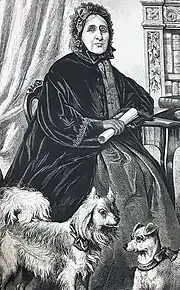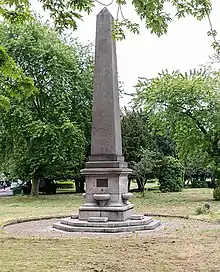Catherine Smithies
Catherine Smithies (née Bywater; 1785 – 1877) was an English philanthropist and campaigner for animal welfare, abolitionism and temperance. She was the creator of the first Band of Mercy, which promoted teaching children kindness towards non-human animals and led to the Bands of Mercy movement.
Catherine Smithies | |
|---|---|
 | |
| Born | Catherine Bywater 1785 |
| Died | 1877 (aged 92) London, England |
| Occupation | Activist |
| Spouse(s) | James Smithies (m. 1812) |
| Children | Thomas Bywater Smithies |
Biography
In 1812, she married James Smithies at St Peter's Church, Leeds. Her son, Thomas Bywater Smithies, the second of ten children, was born in 1817.[1]
After her husband's death, she moved to London to live with Thomas at Earlham Grove House.[1] In the 1860s, Smithies authored A Mother's Lessons on Kindness to Animals, which was published in several volumes.[2] In 1870, along with Angela Burdett-Coutts, she founded the Ladies Committee at the RSPCA.[3] In 1875, she founded the first Band of Mercy.[4]
Smithies died in 1877;[5] on her deathbed she stated: "the teaching of children to be kind and merciful to God's lower creatures is preparing the way for the gospel of Christ."[6] She was buried in Abney Park Cemetery in Stoke Newington, with her son Thomas (who died in 1883).[5] A guard of honor was formed by uniformed RSPCA officers at her funeral.[7]

After her death, Smithies was memorialised by Thomas, in issue number 281 of The British Workman. Smithies' family and friends erected an obelisk and public drinking fountain in Wood Green, London as a memorial.[8]
References
- Murray, Frank. "Smithies, Thomas Bywater (1817–1883), campaigner for temperance and for animal welfare". Oxford Dictionary of National Biography (online ed.). Oxford University Press. doi:10.1093/ref:odnb/74113. Retrieved 2020-06-22. (Subscription or UK public library membership required.)
- Donald, Diana (2019). "The 'Two religions': A Gendered Divide in Victorian Society". Women Against Cruelty: Protection of Animals in Nineteenth-century Britain. Manchester: Manchester University Press. ISBN 978-1-5261-1544-7.
- Scales, Andy. "We remember female trailblazers on International Women's Day". RSPCA. Retrieved 2020-06-22.
- Cronin, J. Keri (2018). Art for Animals: Visual Culture and Animal Advocacy, 1870–1914. University Park, Pennsylvania: Penn State Press. p. 58. ISBN 978-0-271-08163-2.
- Pinching, Albert. "Wood Green's Obelisk". Hornsey Historical Society. Retrieved 2020-06-22.
- Moss, Arthur William (1961). Valiant Crusade: The History of the RSPCA. London: Cassell. p. 37.
- "The History of George Meehan House (formerly Woodside House)". Haringey Council. Retrieved 2020-06-22.
- "Animals". BLT19: 19th-Century Business, Labour, Temperance, & Trade Periodicals. Retrieved 2020-06-22.